Final report for FNC17-1084
Project Information
Good Turn Farm, LLC is a family owned and operated small farm in Stockholm, WI. We currently grow certified organic vegetables, mushrooms, and cut flowers on approximately 2 of our 10 acres. Kevin and Annelie Livingston-Anderson have over 20 years of combined farming and horticulture experience including 8 years of graduate level schooling in the biological and agricultural sciences. We currently sell our crops through a wholesale farmers cooperative, direct to local restaurants and businesses, and direct to local individuals through special orders and local farmers markets.
D&S Gardens is owned and operated by Doug Jorgenson and Sara George, partners in farming and in life. We own 11.5 acres and farm 3 of those acres. We grow fresh fruits and vegetables sell them at farmers markets, restaurants and hospitals locally. Though we are not certified organic, we practice organic methods on our farm. Sara is very passionate about local foods and has managed the Wabasha Farmers Market for the past 5 years, she is on the board for Lake Pepin Local Foods, is the Vice President of the MN Farmers Market Association, the creator of Wabasha Food Access Network and she also works with Renewing the Countryside on various local food projects.
Twin Bluff Farms, LLC is a husband and wife owned and operated small farm business in Stockholm, WI. We currently grow vegetables, annual and perennial fruit crops on approximately 5 of our 21 acres. Steve & Kim Will have over 20 years of farming experience. We currently sell our crops through farmers markets, as fresh food, as processed canned goods and to local vineyards.
Additional Cooperators:
Lake Pepin Local Food Group is a group of producers and consumers located near Lake Pepin, with a concentration of participants located in Pierce & Pepin Counties of Wisconsin. Over 230 individuals and 12 farms have joined our group and many have participated in person at several community meetings since 2015 focused on strengthening our local food economy. Our mission as a group is to bring together local food producers and consumers, working to build a sustainable, vibrant and resilient community with economic opportunity and good quality of life for all.
Our existing Lake Pepin Local Food Group utilized the USDA Local Foodsystems Toolkit to help guide our discussions on moving forward cooperatively to increase local sales of produce from participating farms to restaurants, institutions and individuals. Without economic expertise in our group, we hired a consultant, Ken Meter (Crossroads Resource Center), to provide guidance in our decision making process. We created a thorough review of online sales platforms to share with other farmers and chose one platform to use cooperatively as a group in our area. As part of this cooperative marketing we offered a training workshop for the participating farmers in our area on selling wholesale (pack standards) and our chosen online sales platform, Local Orbit. During the growing season of 2018 we implemented the online sales platform and worked to cooperatively market products from the Lake Pepin Local Food Group.
The Lake Pepin Local Food Group wants to increase the volume of local produce sales in our area using the sustainable agriculture practice of direct marketing. We used the new USDA local foodsystems toolkit (“Economics of Local Foodsystems: A Toolkit to Guide Community Discussions, Assessments, and Choices”) to help guide our group in making the best decisions for moving forward1.
At this point, we believe that utilizing an online platform to streamline direct to consumer sales and cooperative deliveries is the best way for us to increase the volume of produce sold locally. As we started this project, there was an overabundance of online sales platforms to choose from. After working through the Local Food Systems Toolkit and consulting with an experienced local foods economist, Ken Meter, we chose to utilize an online sales platform as well as two local farmers markets to increase cooperative local marketing. As part of that process we researched currently available sales platforms, summarizing the different models, and decided which was the best fit for our unique local food system.
We implemented the online sales platform and two markets in the summer of 2018. We are working to make sure connections with consumers are strong through marketing materials, individual meetings, and continued support during the implementation of the sales platform.
Cooperators
- (Educator and Researcher)
- (Educator)
- (Educator)
- (Educator and Researcher)
Research
Fall 2017 –
- Work through the USDA Local Food System Toolkit with the Lake Pepin Local Food Group. In doing so, we are helping to assess the ease of use and usefulness of the toolkit for small, rural groups like ours. We would be helping to promote the use of this thoughtfully developed resource for the creation of functional local food systems.
- Gather input from local restaurants and institutions and reviewing previously collected data from Wabasha restaurants and institutions collected by the Wabasha Farmers Market manager. This is to help inform our decision in choosing a cooperative marketing model. We want to make sure we are providing a service that is needed.
Winter 2017/2018 –
- Analysis of collected data from consumers & producers in the area.
- Chose a direct marketing method based on collected data.
- Create review of current online sales platforms
- Reach out to local producers with informational materials about the chosen direct marketing method (sales platform) and get farms to join the project; follow up with trainings (on the sales platform, food safety, pack standards, etc.) for interested farms.
- Hold meetings with local restaurants, institutions, and individual consumers to show them how the direct marketing method works for them; follow up with training sessions for interested parties.
- Develop marketing materials to allow participating restaurants & institutions to share with their consumers that they are purchasing local produce.
- Plan delivery logistics for member farmers.
- Hold price planning meetings for producers.
- Coordinate a local drop location for individual buyers
Spring & Summer 2018 –
- Implement the chosen direct marketing method for local producers.
- Make cooperative deliveries to buyers where farms deliver on a rotational basis to cut down on delivery costs
- Continue reaching out to new consumers in a predetermined local area.
Fall 2018-
- Develop & distribute a survey to collect feedback from consumers & producers on how the system worked for them
- Collect data from farmers of total sales resulting from new direct marketing method.
In September of 2017, after the height of the growing season, our steering committee started to meet on a bi-weekly basis to work through the USDA Local Food System Toolkit. Our goal was to utilize the toolkit in our decision making process for moving forward with some kind of cooperative marketing model. After several weeks of reading through chapters and discussing as a group it became pretty apparent that we didn't have the economic research experience necessary to make use of existing secondary data for our community or to effectively design primary data collection methods. We then reached out to our networks and found Ken Meter, MPA and President of Crossroads Resource Center. Ken has a lot of experience working with rural communities on local food system projects, and he was one of the authors of the foodsystems toolkit which made him very qualified! We met with Ken and his advice was that for where our community is at in the process it doesn't make sense for us to go through a full economic impact assessment but instead to put our energy toward a few action items that we had already identified.
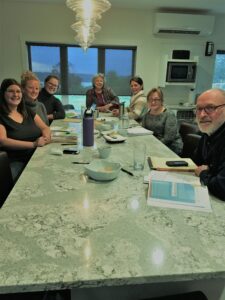
Lake Pepin Local Food Group Steering Committee working through the USDA's "The Economics of Local Food Systems"
Ken graciously presented to our community his findings in February of 2018. In Ken Meter’s presentation he defined community based food system as systems of exchange which strive to bring food producers and food consumers into affinity with each other for the purpose of fostering community health, wealth, connection and capacity. Ken explained that the current system takes wealth out of our communities. His suggestion was to implement a marketing strategy. An example he gave was an “Eat 5, Buy $5” plan where we encourage each resident to eat 5 local fruits or vegetables a week and buy $5/per household member locally. This strategy alone in our small community would render $1.9 Million dollars!
One of our outcomes for this grant was to create a comparison chart for online sales platforms. Sara and Annelie reviewed over 25 online sales platforms and created a succinct, one-page comparison chart for the top contenders based on our research geared specifically for farmers looking to cooperatively market together through the platform (aggregation). Link to pdf of our comparison chart: Online-Platform-Comparison-Chart-
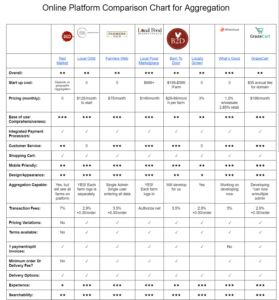
We also conducted interviews with 13 local restaurants and institutions using a survey that we created in collaboration with Ken Meter.
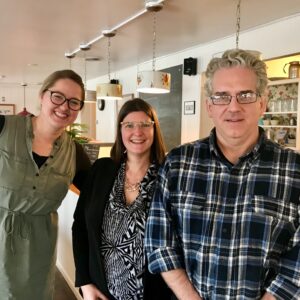
Annelie of Good Turn Farm and Sara of D&S Gardens with Chef-Owner Chris LePoudre of the Homemade Cafe in Pepin, Wisconsin.
Based on our group discussions and some of the preliminary data from our interviews, we moved forward with the use of an online sales platform, Local Orbit, for the 2018 growing season. It was hard to gauge how many farmers and restaurants would actually utilize the platform which of course had an impact on the overall success. Our hope was that the platform would make it more streamlined for local restaurants, institutions, and individuals to purchase produce from multiple local farms with one transaction and then be able to receive one delivery or go to one location for pick up. Ideally this would lower the bar for produce buyers to buy locally and therefore increase the amount of local product they were ordering.
After choosing Local Orbit as our platform of choice, we conducted trainings with our farmers and buyers for the platform. We also conducted training on pack standards so that our farmers would understand what would be expected of them (since many of them were new to wholesale sales) as well as brief training on food safety.
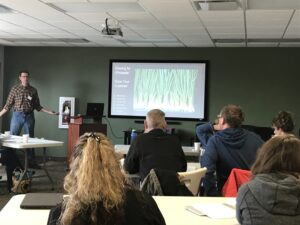
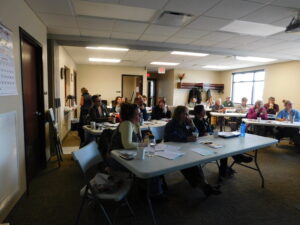
Farmer training that took place were very well attended by local farmers interested in learning more about the aggregation project. David Van Eeckhout, of The Good Acre is seen presenting at this training.
Once our platform was chosen, we had to figure out a lot of logistics around the aggregation of the produce and how deliveries are to be conducted. We decided that Sara George had a close proximity to town, had a walk in cooler available and had a vehicle that was approved for making deliveries, and therefore we chose the aggregation site as her home. One of the benefits of using an online sales platform with the ability to aggregate produce from multiple farms was that it could act as a sort of "online food hub". By only aggregating product that had been pre-sold through the platform, we were able to utilize existing infrastructure like Sara's walk in cooler rather than needing a larger warehouse location for storing product to be sold like some traditional brick and mortar food hubs.
With the platform chosen, the aggregation plans in place, and the training complete, we looked for liability insurance. We realized almost immediately that in order to get insurance as a group, we had to become a legal entity. We had to step away from the grant and do a bit of research on our own to determine the best course of action. The steering committee members chose to form a group LLC and we were able to push forward (in a more organized and informed manner too!). For any groups considering starting a similar aggregation, we would highly recommend tackling the issue of liability insurance and the potential need for forming a legal entity upfront. Although we didn't expect that we would have to form a legal entity as a group when we started this project, we all felt driven to see this project through.
As the growing season in 2018 took off, farmers started to approached us with lots of questions about what they could sell online. Since we are aggregating vegetables, can we aggregate Honey? Maple Syrup? Flowers? What about canned goods like salsas and jam? Homemade breads? Meat? and Eggs? So, we went to the Department of Agriculture and began the conversation to make sure we were compliant with state law. This added another new level to the project that we didn't anticipate. We created a spreadsheet as we learned more about what was legal and what products would need an associated license for selling through the platform.
Farmers started adding inventory to the sales platform. Those items included: fruits and vegetables, herbs and flowers, as well as flax and pizza crusts. Our first order came in July 1st, 2018 and we were so excited to see this cooperative marketing method up and running!
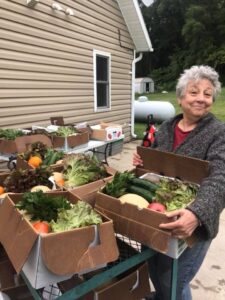
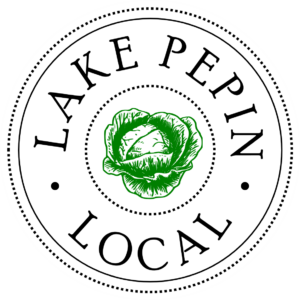
Not only did we begin aggregating produce for deliveries to local institutions (schools, hospitals and restaurants) we did so for
individuals in our community. We also created a Market Share
box (aggregated CSA box)! We started this with 17 individuals
that wanted to subscribe, not huge numbers, but certainly a good start.
Judy Krohn assembling Market Share CSA boxes (aggregated CSA boxes!!) with Sara George (above left). We also created a new logo and a Lake Pepin Local Food Group Brochure.
While working on the aggregation side of things, we were also working to get the word out about this new opportunity to buy local within the community. Annelie was managing the Stockholm Farmers Market and we created a new farmers market in Pepin. She began developing marketing materials to allow participating restaurants & institutions something tangible that would allow them to share with their consumers that they are purchasing local produce.
Marketing local organic produce is reported as a major challenge by 40% and a challenge by 80% of small scale sustainable farmers2. By collaborating with other local farmers, time spent educating the buyers, selling the produce, and delivering the produce can be shared among the participating farms. This increases quality of life for local farmers by profitably marketing with less time investment. By making organic, small-scale farming a more viable occupation in rural communities, we can increase the total amount of organic farming which will benefit the environment and enrich our community.
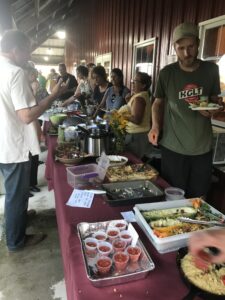
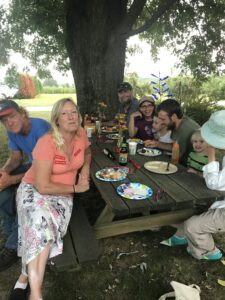
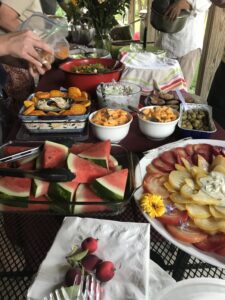
Images from our Lake Pepin Local community potluck in August of 2018
As a part of the marketing approach, we participated in a press tour potluck in our community. We had many writers that attended and learned about our project.
What we found is that the more businesses that we talked to, the more participation we had. We began seeing more orders come through, many were small dollar amounts, testing the process. We were really excited to see this and began opening the ordering platform up to the general public as well.
Unfortunately for us, in June of 2018, Sara George's farm, D & S Gardens, was hit with pesticide drift. Not only did this become a total loss for Sara, it was difficult for our aggregation project because she was one of our 3 main farms in the project. This removed her farm completely. The value of the online sales platform is that it makes it possible for buyers to buy from multiple farmers at one time. Without a lot of product from multiple farms, it might be easier to just order from one farm directly rather than use the platform. We are confident that there would have been more sales through the platform had her product been listed, but the project still moved forward.
In the numbers, we had 11 unique customers including hospitals, restaurants, day cares, grocery stores, food shelves and local individuals that placed orders in 2018. They ordered a combined total of $3111.00 of sales, which may seem small in the grand scheme of things, but due to the late start in the year and the vast amount of infrastructure that this took to get into place and the loss of one of our main farms, we are feeling pretty good about this amount for our first year. We do know that change is challenging and that with time, and commitment, we will see that number increase. For those sales, we had a total of 7 unique farmers who added their product to Local Orbit over the course of the growing season.
Environmental benefits:
By increasing direct marketing of locally grown, sustainable produce in this area, we feel that we could increase demand for sustainable farming acreage. The increased acreage in sustainable/organic farming has environmental benefits in reduced erosion, increased pollinator habitat, and decreased pesticide usage. We are hoping that with more time and development of this project, we will see this to fruition over the next 3-5 years. At this time, we can't prove that we made a big impact, but Local Orbit promotes "how" farms grow (e.g. Organic, Naturally Grown, etc) to the buyers, which we believe will have a substantial effect on how they choose to grow their crops. Businesses are paying more attention to who grows their foods, how they are grown and where. Transparency is one big thing we liked about Local Orbit.
Economic benefits:
The economic benefits of this project include an increase in the amount of food dollars circulating in our local community rather than out into larger, neighboring communities (or California!). Upon surveying the farmers at the end of year 1, (2018) we noted that yes, most of the farmers who participated in the project did indeed see an increase in local sales. This means that we likely kept more dollars in our own community. We are thrilled to see so many support locally.
Social benefits:
Participation in the group and decision making process will increase strength and resilience of farmers in the area due to increased communication among farmers & local consumers. By creating a strong cooperative marketing system, this community can attract more young farmers to the area and decrease the amount of farm consolidation happening. We have discovered that working together on this as a group has proved to be challenging, while building trust within our group, but very valuable in the long run. Not only did we share marketing and advertising, we promoted each other to the community. We worked together sharing equipment when a young farmer was in need. Farm resources were shared as well. There were books that were passed back and forth and there were even trades that took place due to the grant. It was incredible to build this bond in our community and we are excited to see that trust build and grow.
Educational & Outreach Activities
Participation Summary:
- As part of our direct marketing research, we performed a rigorous review of online sales platforms available for small farmers intending to aggregate. This review was formatted in a concise comparison table format and shared widely with other farmers. We shared this document through several Facebook farming groups including: Market Gardeners Success Group (25,784 members), Gardening For Market Facebook Group (3,231 members), Lake Pepin Local Food Group (243 members), Market Gardening Women (588 members), MN Farmers Market Association (1,162 members), Cannon River Sustainable Farming Association (296 members) and more shares happened from there. We submitted this to publications including Growing for Market (15,000 audience), MOSES Organic Broadcaster (12,000 audience) but at the time of this report, they had not yet published the comparison chart. By sharing this resource through several different channels, we will increased awareness in the farming community and encourage other groups to consider aggregating in their community.
- We conducted farmer workshops on food safety and pack standards that were open to all local farmers. These workshops were conducted for early spring of 2018 and brought in 23 individual farmers.
- Social media – we have a Facebook group, Lake Pepin Local Food Group, with 243 members from the area. We posted updates about the work we are doing in the group on a monthly basis. Some people in this group are also farming but not yet actively participating in the Lake Pepin Local Food Group. With more information gained from this Facebook group, they may decide to take a more active role or apply what we learn to their own operation.
- We have shared updates through our facebook group page and group email list on our progress with the toolkit, online sales platform review, and interviews with buyers.
- We have shared information about the Stockholm farmers market and the Pepin farmers market as well as the winter market. We have also shared information about farming classes available, tours, and potluck events.
- we have encouraged community around our facebook group, encouraging connections and inviting new farmers to join our group.
- Press articles
- We had a reporter from the local newspaper come to our community meeting last spring after we received the grant and they ran a story in the paper. "LAKE PEPIN LOCAL FOOD GROUP AIMS TO CONNECT LOCAL PRODUCERS, CONSUMERS" Courier Wedge, Feb 28th, 2017.
- There was an article from the Pierce County Herald on our group called "THE MAGIC OF ART AND NATURE ON DISPLAY AT THE STOCKHOLM STROLL" published July 6th, 2017 informing the public about the farmers markets and the local items that they can find.
- The presentation that Ken Meter gave to our community was reported in the local newspaper and several local businesses attended to learn more about aggregation. We even had our Department of Agriculture representative, Shawn Bartholomew, DATCP. "Lake Pepin Local Food organization gathers for potluck, fellowship, and shared concerns about our local food", Courier Wedge, Mar 1st, 2018.
- Other - the 13 meetings with local restaurants and institutions has brought a lot more recognition to our group in the area. Many of the potential buyers had not heard of our group and were excited to learn about the grant and the proposed cooperative marketing.
- Consultations that we conducted were with each of the 26 online sales platforms that we researched. We learned what each of the platforms were capable of doing, what each platform offered the community, the level of difficulty to implement, and the cost associated with them. Part of our goal for this grant was to utilize an existing online sales platform rather than try to develop something ourselves. There was a wide range of platforms to choose from and we'd highly recommend reviewing them before other groups consider developing their own software/website.
- We consulted with Ken Meter on several occasions as well as David Van Eeckhout, Sarah Lloyd and Mike Travis. All of these agricultural professionals were a wealth of information to steer us in the right direction.
- We co-hosted a press tour with the Stockholm Merchants Association with several (12-18) writers in attendance. There were approximately 50-60 locals in attendance at the press-tour potluck.
- We toured two of our local farms and ended with a potluck nosh and informal brainstorm and review session for Lake Pepin Local Food Group at the Laura Ingalls Wilder Wayside.
- Annelie and Sara presented our project at WFAN (Women's Food and Ag Network 2018). Over 250 women in food and agriculture gathered from 20 different states for this conference. We spoke about our community successes and failures in taking the best steps forward to increase the volume of local produce sales using sustainable agriculture practice of collaborative direct marketing. We shared what we had learned to help others gain ideas to move forward cooperatively and increase local sales of produce in their community! Here you can find our power point.
Learning Outcomes
Most of our work started in the fall of 2017. Some of our major objectives we've worked on in include working through the Local Food Systems Toolkit from the USDA, finding and consulting with a local food system focused economist, reviewing online sales platforms, and interviewing potential wholesale buyers in our area.
Because we didn't have a clear idea of what our next steps should be as a group, when we applied for this grant we knew there was "The Economics of Local Food Systems: A toolkit to guide community discussions, assessments, and choices" publication from the USDA and we hoped that it would help guide our decision making process. There was some insight gained from working through the toolkit as a group but in the end consulting directly with an economist, Ken Meter, who has a lot of experience working with groups like ours proved to be more useful. We as a group did not have any economic training and we basically hit a wall with the prospect of analyzing secondary data for our community in a meaningful way. After consulting with Ken, we actually decided that doing a full economic impact assessment wasn't necessary at this point in time because we are working more directly on relationships with buyers rather than proposing a large investment in infrastructure for example.
The Local Food System Toolkit guided us to define our two biggest goals for our Local Food Group, which we were able to do. Here are those goals:
- to Increase awareness of local farmers and what they have available
- to Increase local sales (to restaurants/institutions and individuals)
For individual farmers, stepping away from the farm work to do marketing and advertising is difficult and often gets ignored. We have discovered that working together on this as a group has proved to be challenging, while building trust among our group, but very valuable in the long run. Not only did we share marketing and advertising, we promoted each other to the community. We worked together sharing equipment when a young farmer was in need. Farm resources were shared as well. There were books that were passed back and forth and there were even trades that took place due to the grant. It was incredible to build this bond in our community.
Using a sales platform and more specifically, Local Orbit, provided a way to increase awareness of local farmers and increase their local sales. From talking with buyers, one of the biggest barriers to buying from local farms was the time it takes to order from multiple farms and to coordinate delivery from those farms. Local Orbit was a way to address both those issues and we are happy with the ease of use and the robust system they have to offer.
We did find that many farmers were slow to use the platform – we believe that was because it required them to indicate what they had for sale, which took time. Ideally they needed to upload pictures, include info about their product, indicate a price, and declare how much they have available. Some of the farmers in our area are well established and have their marketing systems down. There is less interest from them in diving into a new, untested market which is understandable. Some of the farmers simply didn't have enough after their existing markets to add it to the sales platform. We feel that several local farms were watching and waiting to see how the project proceeded before jumping on board, for that reason, we have already committed to continuing this for another year.
Our end of the season surveys for our farmers revealed that Local Orbit was easy to use and the challenge was adding the schedule for it to their already busy schedules. Too often farmers would get knee deep in farming and forget to update what they had to offer. For that reason, we are considering adding a weekly reminder to send out to the farmers to prompt them to add their products in the upcoming year.
The buyers stated in their surveys that they were surprised that they found Local Orbit to be so convenient and user friendly. Many stated that they were able to buy more locally because of the aggregation and the sales platform. The comment we received the most was that the buyers wished that more farmers were involved in the project. We agree and are going to continue to work to engage more farmers.
There is no doubt that year one of using the platforms was filled with start up challenges and building infrastructure. We did apply for a Phase II on this grant and are hopeful that we can push forth with strong efforts on relationship building for both farmers and buyers.
We know that together we are forming a stronger, more vibrant community built around local foods and that right there makes us proud.
Project Outcomes
While "The Economics of Local Food Systems: A toolkit to guide community discussions, assessments and choices" is a well thought out publication it is probably a little too economics focused for most farmers and individual consumers to utilize on their own. We would recommend any community groups like ours to seek out a facilitator and/or economist to help guide the process.
We would highly recommend other communities to begin thinking about working together with other farmers in their community, and more specifically aggregating with other farmers. Farming can be challenging and social connection is a real, valuable outcome of working together in addition to the economic benefit we hope to see eventually. If you build a support system around farming in your community, building each others farms up and promoting them, you will find an incredibly supportive group that you can turn to, rely upon and work with. We are grateful to have this community of farmers and local supporters that we are establishing. We are becoming a team and I can't wait to build upon that relationship in the coming years.
And finally, after all the time researching and developing the write up on all of the online sales platforms; we are extremely happy with our final choice of Local Orbit. We would recommend this online sales platform to small communities that are working together as it is simple to use and easy to adapt to. You can find a variety of products, pricing, lot numbers and trace-ability, there are reports of many kinds available and you are able to set everything specific to your needs.
Information Products
- Online Platform Comparison Chart for Aggregation (Decision-making Tool)
- Lake Pepin Local Brochure (Bulletin)